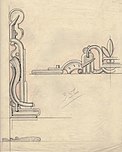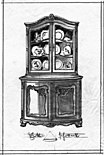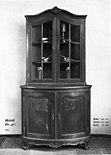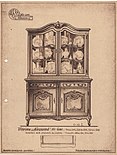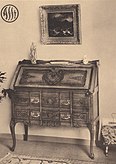Anton Spilker
Anton Spilker (born April 27, 1903 in Steinheim , Westphalia , † February 17, 1973 in Bad Pyrmont ) was a furniture manufacturer, furniture designer , interior designer and sculptor .
Life
Anton Spilker was the first of seven children of the cabinet maker and furniture manufacturer Anton Spilker and his wife Luise, nee. Wedegärtner born in Steinheim / Westphalia. Like his father (1877–1943) and grandfather (1838–1893), he was the firstborn to be baptized “Anton”. In 1864, his grandfather ran the family business “Anton Spilker / Factory carved furniture / Steinheim i. Westf. ”, Which is considered the“ core business of the Steinheim furniture industry ”.
After attending the Rector's School in Steinheim and the Untersekunda at the Gymnasium Theodorianum in Paderborn, Anton Spilker learned the profession of wood sculptor with Friedrich Schönlau in Steinheim from 1919 . This was followed by a year of practical experience at the furniture manufacturer Ziegenhorn und Jucker, Erfurt . From 1923 on, Anton Spilker was able to work in his father's business as a carpenter and above all as a draftsman, whereby his interest in furniture design led him to the architect Korn, Rothemühle / Sauerland for a few months . From October 1926 onwards, internships in Berlin were decisive for his professional development : with the architect Richard Reu, in the Redelsheimer furniture store and with the purveyor to the court, C. Prächtel. At the same time, he took evening classes at the Charlottenburg School of Applied Arts and took courses at the “ United State Schools for Free and Applied Arts ” with Bruno Paul .
Economic problems and family difficulties caused by the death of his mother made Anton Spilker return to Steinheim at his father's request in April 1928, where he supported him in managing the company. In his father's workshop, the junior also prepared for the master craftsman's examination in sculpture, which he passed in 1930. Despite the fruitful collaboration with the father, the economic crisis at the end of the 20s threatened the existence of the father's company with around 20 employees. This situation allowed Anton Spilker to return to Berlin in 1931, of all times, during the greatest unemployment, where he could not find adequate work despite his earlier connections; Odd jobs like restoring old furniture were done. On February 27, 1932, Anton Spilker married Elsa Ondrusch from Leobschütz / Upper Silesia , who also came from a family of carpenters and sculptors.
When general conditions stabilized from 1933 onwards, Anton Spilker started his own business as an interior designer and from October 1934 he and his wife opened the furniture store “Heimkultur” at Kaiserdamm 24 in Berlin-Charlottenburg. The business developed successfully in six years. It was closed because of Anton Spilker's entry into the Wehrmacht in November 1940.
Anton Spilker survived the war and returned to Steinheim from Soviet captivity on June 28, 1945. The father died here in the spring of 1943, and in the meantime his wife Elsa and their daughter Ursula, born in 1937, had moved from Berlin to this place. As his father's successor, Anton Spilker restarted the business that had been idle during the war. First of all, simple emergency furniture was manufactured for the occupying power according to the rules of the strict forced economy. Only with the currency reform in June 1948 was he able to switch to the production of high-quality furniture.
Anton Spilker followed up on the richly carved individual pieces of furniture offered before the war, which he himself had designed in Berlin for the Steinheim company in the years 1936–1937. Now he has revised it based on the model of the “ Aachen-Liège Baroque ”. The sale developed successfully. To meet the demand, the capacity of the factory was expanded. In 1952/53 a modern company building was built in the new industrial area of the town of Steinheim, with the workforce initially growing to around 50 employees. Two more extensions followed in 1958 and finally in 1962/63 with an L-shaped factory complex.
On October 6, 1956 Elsa Spilker died, who had stood by her husband during the years of construction in Berlin and Steinheim.
At this point in time, an adjustment in the corporate structure was initiated in the rapidly growing business activity. When assigning tasks to responsible employees, Anton Spilker reserved the design and further development of the style furniture in Aachen-Liège Baroque, the design of sales documents and the acquisition of the dealership customers.
Anton Spilker married Cäcilia Beller on July 17, 1960. In 1963 their son Antonius was born.
The company's greatest operating performance was achieved in 1965/66 with 114 employees and 40 freelance wood sculptors. The market had changed almost unnoticed in these years: the “ seller's market ” had become the “buyer's market ”. A rethink was required for which one was little prepared.
Daughter Ursula worked as a woodworking technician and interior designer in the company in 1965 during the boom phase.
At the beginning of the 1970s, Anton Spilker was still experiencing the signs of recession due to stagnation in sales. When he died on February 17, 1973, however, he could still enjoy the success of his life's work without restriction.
Create
Anton Spilker showed a special talent for drawing even as a child, and he also enjoyed doing it intensively. He was undoubtedly given a lot of inspiration for this while growing up in close connection with the furniture workshop, where his father spent a lot of time at the drawing table with the design and detailing of the furniture to be made.
It was characteristic that Anton Spilker decided to become a woodcarver when choosing a career from 1919 onwards. Here the young aspirant wanted to learn the ornamental design language of the well-known furniture styles and acquire the artistry to replicate. After the manual apprenticeship, the special selection of his internships and activities proved to be suitable to deepen and supplement his skills in practice and theory. He made very conscious use of the opportunities offered and showed a lot of initiative in order to follow his artistic ambitions, especially with drafts.
From 1926 in Berlin - during the " golden twenties " - the budding interior and furniture designer was able to expand his professional experience through his position with architects, in the furniture trade and shopfitting . The clients were still strongly associated with the style furniture forms from the tradition of historicism , but the new developments such as " Art Deco " and " Bauhaus style " gained in influence. Anton Spilker was the focus of the discussion - in his professional practice and as a student at the Berlin institutes - with the new design principles. As a sculptor and connoisseur of the historical ornament styles, he also devoted himself to the art deco, which appealed to his creativity and his artistic sense, in addition to the style drafts. In this decorative style, Anton Spilker designed some striking individual pieces of furniture and furnishing ensembles, such as the communion bench in the Catholic church in 1930 . Parish church in Steinheim.
In 1930, Anton Spilker demonstrated his skills as a sculptor in the master's examination with the overall rating “very good”. As a masterpiece, he reproduced the larger than life late Gothic figure “Madonna and Child” on the gable side of Thienhausen Castle near Steinheim.
In the economic upswing from 1933 onwards, Anton Spilker experienced a new challenge from his furniture business "Heimkultur". The offer consisted of high-quality period furniture from well-known manufacturers and his father's cabinet maker in Steinheim. As an interior designer, Anton Spilker offered prospective buyers comprehensive furnishing advice, which often took place directly in the customers' homes. With clear spatial perspectives , he was able to win many a large order. The successful business activity was largely based on recommendation.
Anton Spilker had taken over the design and detailing of new production models from Berlin for his father, who was also experiencing an upswing in the Steinheim art cabinet maker. A lively exchange developed, with design and manufacturing drawings being sent from Berlin to Steinheim. Various new models and programs were created that promised good sales prospects. However, it was not until 1936 that a resounding success began.
The furniture workshop in Steinheim, known for the best craftsmanship, received the recommendation from furniture dealers in the Rhenish-Westphalian region to develop richly carved single pieces of furniture in solid oak “based on the Belgian model in the Louis XV style ”. The father commissioned Anton Spilker in Berlin, who had a preference for the refined baroque / rococo ornamentation, with the design. The cabinet making in Steinheim immediately developed the prototypes with the best local sculptors. The orders from well-known period furniture houses in major German cities followed immediately. In the spring of 1939 a catalog appeared with a selection of richly carved individual pieces of furniture: chests of drawers , mirrors, secretaries , etc. The Second World War brought an abrupt end to all hopeful activity.
After taking over his father's business, Anton Spilker was only able to think about the implementation of the plans with the currency reform in 1948, which he linked with the continuation of the "factory carved furniture" founded by his grandfather in 1864. In this situation it was a matter of course that he would expand the “Belgian collection” that was so successful in the pre-war period. After all, he had designed this furniture down to the last detail in Berlin. Now he has revised it from the ground up and published it under the style name “Aachen-Lütticher Barock”. He relied on art historical literature, above all on the work of Paul Schoenen "Aachen and Liège furniture of the 18th century".
In the three decades that followed, Anton Spilker created the comprehensive range of styled furnishings in “Aachen-Liège Baroque”. Its decorative design was clearly based on the historical style of the Aachen-Liège Baroque, but fully took into account the modern application possibilities. This development was not so much the result of deliberate planning by the designer, it was rather initiated by the client through suggestions and requests in the sales talks. In the end, the customer had an offer that, in terms of type selection and usability, was absolutely the same as the products that were becoming increasingly important in their simple, modern design.
Just as consistently as with the standardization of the model types, modern production methods and modern materials were used for the Spilker style furniture in Aachen-Liège Baroque. Even in the 1950s, modern series furniture production would have been inconceivable without the mechanical preparatory work of profiles, curves, constructive connections, etc.
The published catalogs clearly reflect the development of Spilker style furniture in Aachen-Liège Baroque. Around 1950 the range still contained around 50 models: small pieces of furniture such as chests of drawers, mirrors, consoles, hat shelves, umbrella stands, wall cupboards , wall boards, grandfather clocks, desks, secretaries, shelves, cupboards, small tables.
Around 1955, the range was significantly expanded with a variety of models for furnishing dining and living rooms: sideboards, showcases, dining tables, standardized living room cabinets with a large selection of equipment, coffee tables, music chests and television cabinets for concealing the bulky devices of the time.
Around 1960 the wall unit found its way into the modern sector , and Anton Spilker followed suit. Given the multitude of carved doors and drawers on a wall unit, the high prices were particularly significant. Anton Spilker developed a simpler variant of the fronts, which he designed based on models in the “Lorraine Baroque”. This variant harmonized with the simpler, but closely related design with the other furniture in Aachen-Liège Baroque.
By 1965, the individual wall unit combinations had already accounted for a large proportion of sales. Wall units were created, not only from wall to wall and from floor to ceiling, but also with corner solutions, superstructures of sofa niches or room doors, as well as many adjustments to existing rooms based on precise measurements.
In the 1970s, a complete interior design program including room doors and wall paneling was available, as was the bedroom in Aachen-Liège Baroque with the infinitely adaptable wardrobe wall, with beds, bedside tables and other accessories.
From the end of the 1950s, fundamental criticism of period furniture became increasingly loud. In order to strengthen the appreciation of period furniture, the " German Style Furniture Working Group " was set up in November 1958 . Anton Spilker was one of the seven co-founders. The aim of the community was to “maintain the stylish forms of living in historical art epochs in order to preserve them for the present and the future.” The concept was convincing and the advertising in the main living magazines did not fail to have an impact.
The Spilker style furniture in Aachen-Lütticher Baroque was viewed within the working group as particularly exemplary for high-quality style furniture from the start. During his lifetime, Anton Spilker showed himself to be an active member and was always available when it came to the interests of the period furniture manufacturer community.
However, as early as the early 1970s, it gradually became clear that the popularity of period furniture was generally waning. Anton Spilker did not experience the sales problems of the period furniture industry that began to rise later.
On the death of Anton Spilker on February 17, 1973 one finds detailed appraisals not only in the regional press, but also in the specialist organs.
In the MÖBELMARKT it says in the obituary of the working group Deutsche Stilmöbel e. V., Detmold: “With him, we and the German furniture industry are losing a man whose life's work made our time richer. With his furniture, created in the spirit of the Aachen-Liège Baroque, he has set himself a permanent monument. "
Addendum
Anton Spilker had appointed his two children Ursula and his underage son Antonius as heirs. A GmbH & Co. KG was founded with Ursula Spilker as managing director.
The years after Anton Spilker were characterized by increasing sales problems. The macroeconomic effects, also as a result of the oil crises of the 1970s, also affected the furnishing industry in western Germany - and especially the period furniture industry.
A general change in taste took place, the new generation of buyers preferred the simple, modern design. In addition, with the typically higher artisanal share of richly designed furniture forms, the costs and thus the prices rose disproportionately - a consequence of the rapid wage increases in the 1960s to 80s with a simultaneous decline in the number of items.
A fatal situation that led to the bankruptcy of Anton Spilker on October 16, 1986. The upholstered furniture manufacturer Ludwig Finkeldei, Nieheim took over the company and continued to offer Spilker style furniture until the company was transferred to another company with a different program in 1992.
literature
- Julius Keil: Anton Spilker Stilmöbelfabrik Steinheim / Westf . In: Wirtschaftslesebuch-Verlag Dr. Julius Keil: The West German economy and its leading men. 7th volume of the Germany series. Oberursel near Frankfurt / Main 1969, pp. 391–393.
- Ursula Spilker: On the 100th birthday of ANTON SPILKER, his life's work . Announcements of the culture committee of the city of Steinheim, issue 56, March 2003.
- Ursula Spilker / Johannes Waldhoff: 1864 to 2014 - 150 years of Steinheimer Möbel. Local history and folklore writings of the town of Steinheim Volume 17, Förderverein Möbelmuseum Steinheim (Ed.), Steinheim 2014, pp. 261–262.
- Paul Schoenen: Aachen and Liège furniture of the 18th century . German Association for Art History, Berlin 1942.
- Dagmar Preising , Ulrich Schäfer: Couven Museum in Aachen . Deutscher Kunstverlag Berlin Munich 2010, ISBN 978-3-422-02289-8 .
- Wolfgang Zahn: The Red House in Monschau . In: Rheinische Kunststätten . Issue 76. Rheinischer Verein für Denkmalpflege und Landschaftsschutz, 5000 Köln 21 (Ed.), 6th revised edition, 1984, ISBN 3-88094-483-0 .
- Alexandra Bloch Pfister: From Aachen-Liège to Eastern Europe. The Steinheim production of furniture as a cultural asset in a European context. Förderverein des Möbelmuseum Steinheim (publisher), narrative café in the Möbelmuseum Steinheim on May 5, 2018. Print Rainbowprint, Zellingen-Retzbach 2018.
Web links
- Homepage of the Furniture Museum Steinheim (Westphalia) with exhibits from the Anton Spilker period furniture factory
| personal data | |
|---|---|
| SURNAME | Spilker, Anton |
| ALTERNATIVE NAMES | Spilker, Anton August (full name) |
| BRIEF DESCRIPTION | German furniture entrepreneur, furniture designer, interior designer and sculptor |
| DATE OF BIRTH | April 27, 1903 |
| PLACE OF BIRTH | Steinheim , Westphalia |
| DATE OF DEATH | 17th February 1973 |
| Place of death | Bad Pyrmont |

